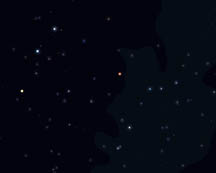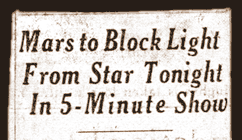|
Now
here's a "total solar eclipse" of an even rarer kind. Hope
it comes as an Ultra-Surprise to even the most sophisticated
of you. During this astronomical event the object blocking
out a stellar disk was not our moon, but the planet,
Mars.
And the stellar disk in this case was not our own local
star, "Sol", but the third magnitude Epsilon
Geminorum. It's in
the right twin's "leg or body", a bit lower than midway, in
the constellation, Gemini (which is shown rotated CCW to the
left by about 45 degrees above). This is a noticeable
constellation above and to the left of Orion, as seen from
the Northern Hemisphere, and contains the sister twin stars,
Castor and Pollux.
You can see Gemini in
the stellar view at the top of this page. The twin stars are
the bluish-gray pair towards the upper left, which form the
top of the constellation, the "heads" of the twins, in many
visualizations. The slightly yellower "star" somewhat below
them is actually the planet, Saturn. The next brightest
object is the reddish-orange speck just above and to the
right of center, the planet Mars. It was nearly full (90%)
on that date, with a quite small diameter of 6.4" of arc (at
its closest Mars can measure nearly four times that size).
The date for this configuration? Some years ago, in the
Spring of 1976.
The exact date was
April 7th, and a headline from a decaying clipping (I
somehow saved) from the New
York Times for that
day is shown above. You might enjoy reading the
whole
clipping, here
(or just
click the headline image above; note the entire contents of
the clipping are ©1976, The New York
Times). This event
seemed to sneak up on the astronomy professionals. Perhaps
they were being cautious. Sky
& Telescope
magazine mentioned it in their March 1976 issue, rather
shortly before the occultation
(for that's what such events are called), not providing us
with their usual long lead time. Occultation is a more
general term than "eclipse"; it's usually applied to the
passage of the Moon in front of some star or planet. (FYI:
yes, a total solar eclipse is really "just" an occultation
of the sun by the moon.) The calculations here were critical
(Mars' orbit was not so well known until later, via space
probes), so early predictions about this occurrence would
have suffered a lot in accuracy.

Path
of Mars' Occultation of Epsilon Geminorum (L to R) on
4/7/76
(Times along tick marks are given in GMT for
April 8th, near 1 AM)
As it happened I was living
on the upper West Side of Manhattan at the time, and had
very recently acquired a used Celestron
14" telescope at a
very good price. There aren't many opportunities you
encounter to use such a big instrument from the big city --
this would be a dandy opportunity! As the path you see above
was finally calculated, NYC would be only a little north of
the central line of the path (just like for a solar eclipse,
a good place to be is right on the centerline!). This would
be a neat astronomical event to witness, and perhaps to
photograph.
With the help of a
good, curious friend, we managed with effort to lug the
sections of the C-14
up onto the roof of the building, and put them together
while it was still light out. The image shook when we walked
about, but if we were really still it was just fine. Mars
appeared visually as a reddish-orangey globe (it was not
particularly near Earth at this time), very different to
observe than a star. Even the nearest star in a telescope
presents but a small speck bright of light, a "fuzzy point".
No stellar disk can be seen from Earth (except our Sun),
even using high magnification.
Epsilon Geminorum is a
3.5 magnitude star, not one of the brightest, even a bit on
the dim side for NYC's light-polluted skies (we've gotten a
LOT better in the decades since 1976, with special
light-safe street lighting, and other methods). But April
seventh turned out luckily to be a lovely mild, cloudless
early Spring evening (the critical five minutes were
centered on 8 PM EST, by which time it was definitely night,
a magical night for some of us).
I also attached my
faithful Topcon RE (you'll
see my drawing of it on top of our Photos
Page)
to the telescope. I have a special right-angle magnifying
viewfinder Topcon made for it (huge sharp and ultra bright
images -- try that with any recent camera), and a special
telescope focussing screen (aerial image, no omnipresent
matte groundglass, which impairs viewing), that were
designed just for highly-magnified images like this. I tried
using "eyepiece projection," a well-known technique that
produces a fairly large planet size in photography --
otherwise you get just a teensy disk on film. On a final
tech note, I made the exposures on an unusual new Kodak film
made with microfine grain. Many of the 36 images were a bit
blurred by our excited pacing around the roof as the once in
a lifetime event proceeded. But half of them are just
fine.
Mars
"Eclipses" a Star
(Click
image for the complete sequence)
Here is one of the
pre-total images above. Click it for the complete
nine-image sequence,
assembled as a 3 by 3 composite. The progress over time is
as you read: left to right, then down. The central image was
taken at the middle of "total eclipse", so no star can be
seen. You can see above that Mars' orange globe is about to
pass directly over the small bluegray star to its left,
which was about one-ninth as bright as Mars at the time.
There was some scintillation (atmospheric disturbance), so
the star is not quite as tiny and sharp as usual. The planet
moved in its usual right to left (West to East) direction,
this being the Northern Hemisphere. The whole sequence shown
lasted less than a half hour; these nine images are
symmetrically spaced over time. The total duration of the
"eclipse" of the star was about 5 minutes. And the
interesting portions of just covering, or just uncovering
the star (the 4th and 6th images) lasted but a matter of
several seconds apiece.
That's a pretty neat
coincidence, as these times are very similar to those of a
longish total solar eclipse seen on Earth. Unfortunately,
the daylight didn't go "Out" with complete immersions -- it
already WAS out, as it was past all but the final stages of
twilight by 8 PM. If it had been daytime, the thing would
have been pretty difficult to observe, even if you knew
exactly where to aim a scope, as the sky's light would have
swamped the star for sure, probably even Mars. People out on
the street never noticed anything remarkable was happening.
For that you needed good binoculars or a telescope, and the
bit of knowledge of when and where to look... (We've also
heard of many auto drivers who keep on driving during a rare
total eclipse, just turning on their headlights(!) -- is it
too much effort to see one of nature's most remarkable
displays?)
The planet Mars is so
noticably reddish when seen through a telescope that it
tends to make nearby stars take on a complementary hue, a
contrast effect of the eye and brain. The sky appears mostly
dark and without much tint, so it provides little clue as to
what is neutral, what is colored. To me epsilon geminorum
appeared to have a very distinct cyan cast, much bluer than
in the photos above. And at brief moments of better seeing I
could detect a little of the Mars surface, which doesn't
fare so well in the photographs (the star would look much
sharper and smaller at moments, too). Otherwise the nine
image sequence is very faithful to our visual impressions.
As I look at them now it becomes a virtual time-machine back
to that lovely evening's experience.
Later I learned that
the airplane-based Kuiper Airborne Observatory had been
flying along the centerline during the occultation. Their
sensitive digital devices picked up a momentary brightness
"spike" right at the middle of "totality." This indicated
that Mars had a measurable atmosphere (the way the light of
the star gradually faded just before and after totality was
further proof). We learned a lot more in a few months, as
Viking probe was about to land on Mars. It's interesting: at
the jump in brightness the planet's atmosphere acted as a
convex lens, and slightly magnified the total light amount
being focussed back to Earth. Neat. (BTW: I doubt that NYC
would have observed this effect, being a bit above the
centerline. So, no, I didn't see the mild brightness spike,
or my camera's shutter interrupted it.)
Okay, so this may seem
to be a rather sneaked-in event for an "Eclipse Page". But
as you have read, it's not actually that much of a
force-fit. And on this website this seemed the best place to
locate this description. You may be amused to learn I just
found the negatives, after having misplaced this strip all
these years, moreso when I last moved. I'd never printed
them when they were "new", but put aside the uncut length of
35mm film for enlarging later, "when I had time." (Ha!) Now
such things are MUCH easier with my trusty PowerMac. So I
scanned the negatives of the best images into PhotoShop, and
cleaned them a bit and assembled the best ones as you see
them here. It's the first time I've seen final prints from
photos I took of a rather extraordinary event from quite a
long time ago! (A
smiley face could
go here:)
--Wendy
Carlos, March 15, 2000
|


 Once
every 300-400 years...
Once
every 300-400 years...

![]() (Top
of the Page)
(Top
of the Page)![]() Back to the Eclipse Page
Back to the Eclipse Page
![]() Back to the Wendy Carlos Home Page
Back to the Wendy Carlos Home Page ![]()